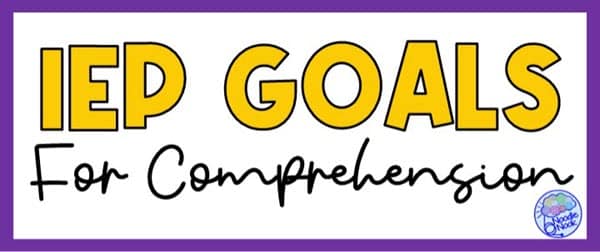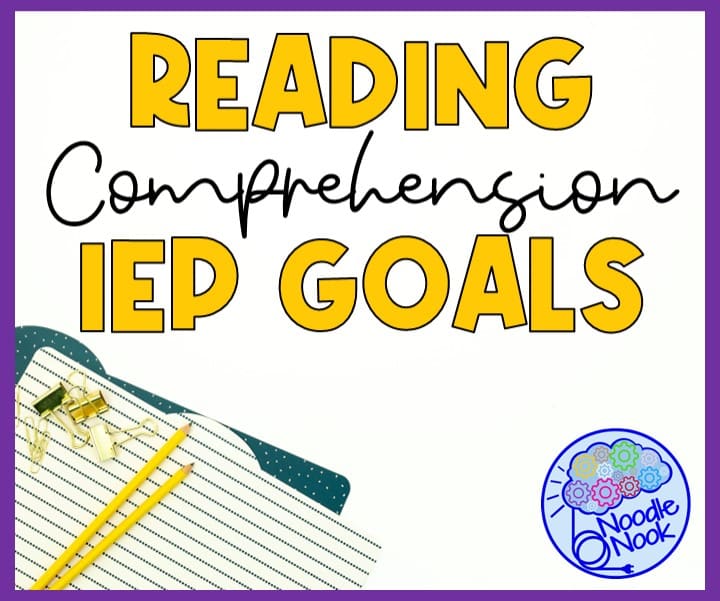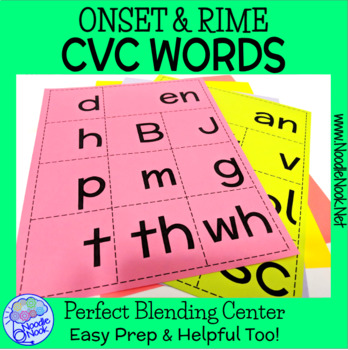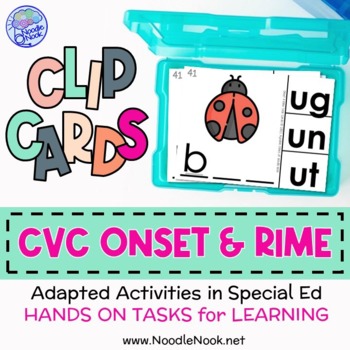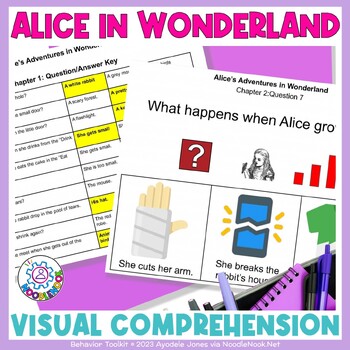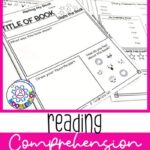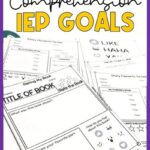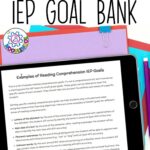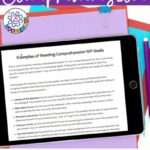Reading comprehension is a crucial skill for students to master, regardless of their ability level. For students with significant disabilities, however, this can be particularly challenging. As a teacher, it’s essential to set meaningful, achievable, and measurable IEP goals to help special education students develop their reading comprehension skills. In this blog post, we’ll discuss strategies for creating practical reading comprehension IEP goals that target the special needs of students with special education services.
What are the Pillars of Reading?
The pillars of reading refer to the fundamental skills that are necessary for developing strong reading abilities. They were outlined by the National Reading Panel over twenty years ago. There are five pillars of reading, each of which plays a crucial role in developing proficient readers. These pillars are phonemic awareness, phonics, fluency, vocabulary, and comprehension.
Every student needs a solid foundation in each of these pillars to be a successful reader. Furthermore, it’s critical for a student to be successful with their grade-level aligned common core standards. Here’s an overview of each pillar:
- Phonemic Awareness: This refers to the ability to hear, identify, and manipulate individual sounds (phonemes) in spoken words. Phonemic awareness is a foundational skill that helps students develop phonics skills, decoding skills, and reading fluency.
- Phonics: Phonics is the understanding that there is a predictable relationship between phonemes (sounds) and graphemes (letters). Phonics skills allow students to decode words they encounter in reading.
- Fluency: Fluency is the ability to read accurately, quickly, and with expression. Fluent readers are able to read smoothly, without stumbling over words or losing comprehension.
- Vocabulary: Vocabulary refers to the words a student knows and understands. A strong vocabulary is important for reading comprehension because students need to understand the words they encounter in text.
- Comprehension: Comprehension is the ability to understand what has been read. It involves making connections between what is being read and what the reader already knows, as well as making inferences and drawing conclusions based on the text.
Each of these pillars of reading is interconnected, and it is important for students to develop strong skills in each area in order to become proficient readers. The only thing that isn’t listed by the National Reading Panel as a pillar is writing. Reading and writing go hand in hand. When we strengthen one, we see the other improves as well. Effective reading instruction will address each of these pillars in a balanced way, as well as writing skills.
Understanding the Student’s Abilities
As you get started with targeting comprehension IEP goals, it starts with assessment. It’s important to take the time to determine students’ current reading levels and comprehension skills. That’s how you get started figuring out how to support the student with specialized instruction and the extra help they need.
Students start addressing reading and comprehension from their first year in school. They continue to focus on comprehension of grade-level text in all academic areas all the way through high school. That’s much different than specific reading skills. We teach children HOW to read from their first year through second grade. At the third grade level, the focus stops being on HOW to read and shifts to focus on WHAT you’re reading. In other words, on reading comprehension.
Every year as a teacher, you’ll want to determine student reading levels. That way you can tailor your instruction, provide instructional level texts, and target learning key information in a way that’s meaningful for the students.
Assessing Reading Level
At the beginning of the year, give students reading tests to assess their reading level. This can be done using a formal evaluation system or informally with curriculum-based assessments or objective tests. The outcome that you’re hoping for is a better understanding of individual skills. That means using informal reading inventories, running records, and comprehension probes to determine the student’s strengths and weaknesses. These tools help you identify specific areas where your students may be struggling. This may be in identifying main ideas, making inferences, or understanding vocabulary. By targeting different strategies, you’ll tailor your instruction effectively.
Remember Student Needs
When creating reading comprehension goals for your students, it’s important to consider their individual needs and abilities. This means taking into account their communication mode, sensory needs, and cognitive abilities. For example, a student with a visual impairment may benefit from the use of braille or audiobooks, while a student with an intellectual disability may require simplified text or visual support.
By considering these factors, you can create goals that are challenging yet achievable for your students. You can also use different strategies or accommodations to help them succeed. Reading is one of the most important life skills a student can strengthen. By taking their individual needs into account, you can help your students make progress by their next IEP meeting. They can then take those skills forward to support them throughout their adult lives. Read more below on specific strategies that can support your students.
How to Set SMART IEP Goals
Creating SMART goals is an important step in helping students achieve success in reading comprehension. SMART goals are specific, measurable, achievable, relevant, and time-bound. By setting goals that meet these criteria, teachers can help students stay focused and motivated, and track their progress over time.
Specific goals help students understand what they need to do to succeed, while measurable goals allow them to track their progress and celebrate their successes. Achievable goals are challenging yet attainable, while relevant goals are connected to the student’s overall learning objectives. Finally, time-bound goals provide a sense of urgency and help students stay focused on their objectives.
In addition, as you draft reading comprehension IEP goals, focus on the 4 essential elements of a goal. That includes the timeframe, condition, behavior, and criteria. You can read more about these criteria here.
By setting SMART goals, teachers can help students take ownership of their learning and develop the skills they need to become confident and successful readers.
Examples of Reading Comprehension IEP Goals
This is a list of sample reading comprehension goals. It’s not a comprehensive list, but it serves as a starting point for IEP teams to draft great goals. These goals can be tailored to meet the specific needs of each student. They should take into account the abilities and needs of a specific student.
Setting specific reading comprehension goals can help students stay motivated and make progress toward their learning objectives. Here are some examples of SMART goals for different areas of reading comprehension:
- Letters of the alphabet: By the end of the school year, when presented with capital letters of the alphabet, the student will correctly identify the letter’s sound at least 90% of the time.
- Main idea of a text: By the end of the semester, after reading a passage, the student will be able to identify the main idea with 80% accuracy.
- Phonemic awareness: By the end of the grading period, the student will be able to segment and blend words with three phonemes (e.g., “cat” or “dog”) with at least 80% accuracy.
- Unknown words: By the next annual IEP, when encountering an unfamiliar word, the student will use context clues to determine the word’s meaning with 80% accuracy.
- Key information: By the end of the school year, when presented with instructional level text, the student will be able to identify at least three key pieces of information in a passage by choosing from an array of at least 5 with 90% accuracy.
- Reading fluency: By the next annual IEP meeting, when presented with a grade-level passage, the student will read with a fluency rate of at least 100 words per minute.
- Inferential questions: By the end of the spring semester, when given text that is read aloud or as an audiobook, the student will answer inferential questions about a text by typing on a word processor or using their voice output device with at least 75% accuracy.
- Organization skills: By the end of the school year, when presented with reading material, the student will use graphic organizers to organize their thoughts and ideas while reading by accurately filling in the organizer with 80% accuracy. (Read More: Improve Comprehension with Graphic Organizers)
Remember…
The key here is to set specific goals with clear timeframes, conditions, behaviors, and criteria. When we do this, it’s easier to measure and track a goal, and don’t we all want to make data collection easier? You can focus in on any aspect of comprehension, depending on the needs of your students. This could include focusing in on reading sight words, reading letters or making letter sounds, blending and chunking to decode unfamiliar words, or answering comprehension questions.
If the focus is on writing as well as reading, then you may want to consider goals that target both. That could include using sentence starters or word banks to answer questions. It could be by showing an understanding of informational text by writing responses in complete sentences. You may also consider assigning homework assignments that use reading to target writing. Either way, start with a great goal to help students make progress toward their learning objectives and feel a sense of accomplishment as they achieve their goals.
Tracking Reading Comprehension IEP Goals
Regular assessment and progress monitoring are crucial steps in ensuring that students with significant disabilities make progress in their reading comprehension skills.
Teachers can identify areas where a student may be struggling and make adjustments to their instructional strategies by conducting assessments and monitoring progress. It’s also important to revise goals as needed, based on the student’s progress toward their objectives. If a student is consistently meeting their goals, teachers can make their goals more challenging to help them continue to grow and improve. On the other hand, if a student is not making progress toward their goals, teachers may need to adjust their goals to make them more achievable or modify the instructional strategies being used.
By tracking progress and revising goals as needed, teachers can guarantee students receive the support they need to succeed in reading comprehension.
Incorporating Evidence-Based Strategies
In addition to setting specific goals and tracking progress, special education teachers can use evidence-based reading comprehension strategies. These help students with significant disabilities succeed in reading comprehension.
Graphic organizers, visual supports, and repeated reading are just a few examples of these strategies. Graphic organizers can help students organize their thoughts and ideas, making it easier to understand the main idea of a text. Visual supports such as pictures or videos can also help students make connections and better understand the content. Repeated reading involves reading the same passage multiple times, which can improve a student’s reading fluency and comprehension.
By incorporating these evidence-based strategies into their instruction, teachers can help students develop the skills they need to succeed in reading comprehension.
Examples of Evidence-Based Practices for Comprehension
There are a variety of strategies that can be used to support students in developing their reading comprehension skills. Here are a few examples:
- Graphic organizers: These tools help students to organize their thoughts and ideas while reading. They can be used to help students identify main ideas, supporting details, cause-and-effect relationships, and more. Using a graphic organizer is essential for any student to access academic standards.
- Visual supports: Visual aids such as pictures, charts, and diagrams can help students better understand the material they’re reading. This is particularly helpful for students who struggle with abstract concepts.
- Repeated reading: Encouraging students to read a text multiple times can help them to improve their fluency and comprehension. This strategy is particularly effective for struggling readers.
- Questioning: Asking students questions before, during, and after reading can help them to stay engaged and improve their understanding of the material. Teachers can use both open-ended and closed-ended questions to encourage critical thinking.
- Summarizing: After reading a text, students can be asked to summarize the main ideas and key details. This helps them to consolidate their understanding of the material and identify the most important information.
Using these supports is an evidenced-based strategy that supports students with complex access needs. Moreover, it’s also a great way to incorporate instructional best practices into your classroom.
Don’t forget about the power of direct instruction and explicit instruction. Teaching students by modeling for a student, giving them opportunities for guided practice, and then allowing for independent practice should also be the backbone of your classroom system. Intertwine all the strategies above to support solid reading comprehension IEP goals and you’ll see how easy it is to address reading with your students.
RECAP: Reading Comprehension IEP Goals
Reading comprehension is a vital skill for all students, including those with significant disabilities. As special education teachers, we must create effective IEP goals that target the unique needs of our students. By understanding our students’ abilities, setting SMART goals, incorporating evidence-based strategies, and collaborating with other professionals, we can help our students achieve success in reading comprehension.

